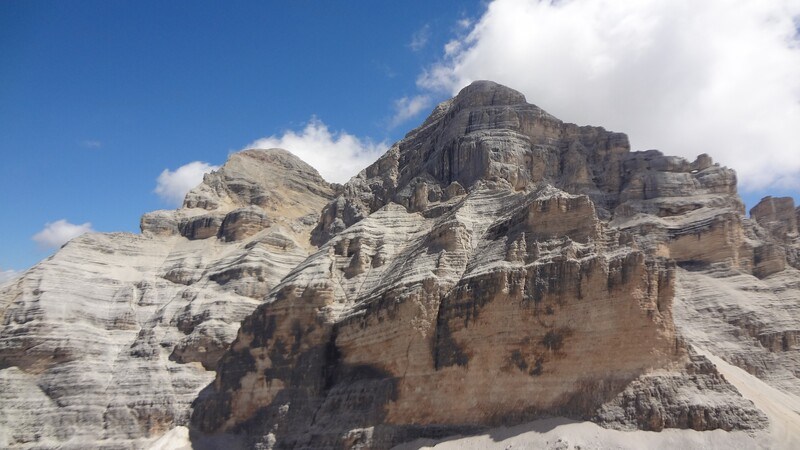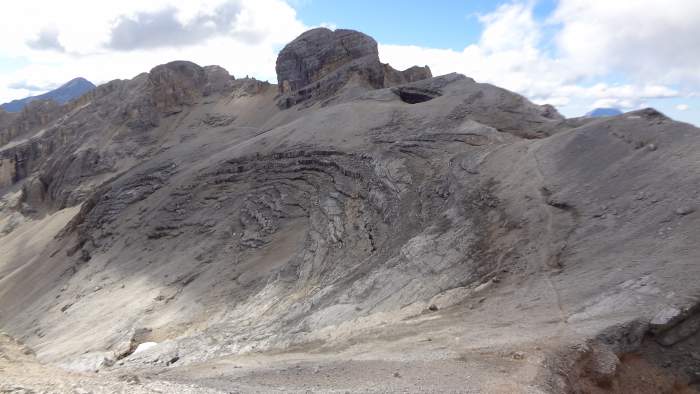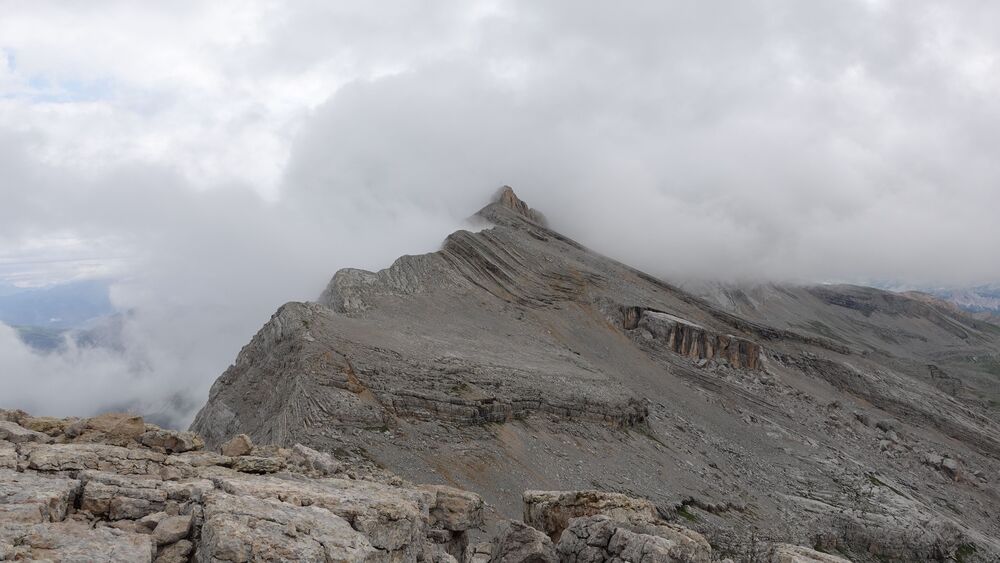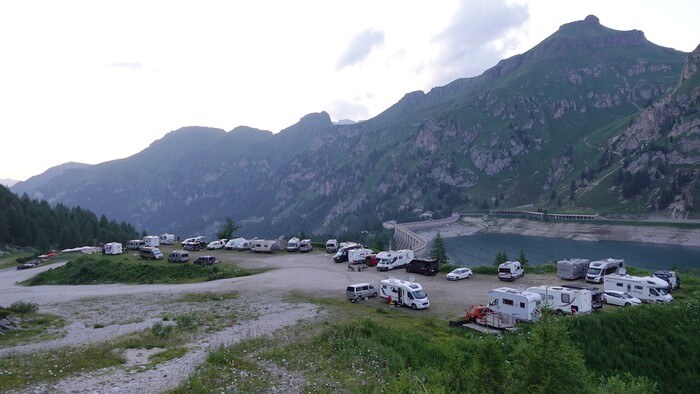Here you have my interactive map with locations for 56 peaks in the Dolomites that are over 3000 meters high, with plenty of information regarding routes, equipment, and accommodation.

How many 3000ers peaks are there in the Dolomites?
The number of 3000ers in the Dolomites could be anywhere in the range 18-50+. It all depends on how a peak is defined, hence a variety of numbers mentioned in various sources.
If you go to Wikipedia, you will see 21 of them listed, with the highest being Marmolada (3343 m, 10968 ft) and the lowest Kesselkogel (Catinaccio d’Antermoia, 3004 m, 9856 ft).
It is interesting that the most famous Tre Cime di Lavaredo are not included, only one meter of difference in height excludes them from the 3000ers list.
But the number of peaks depends on how you take into account the topographic prominence of a peak.
What is the topographic prominence of a peak?
According to Wikipedia, the prominence, or autonomous height, or relative height, or shoulder drop is the height of a peak relative to the lowest contour line encircling it but containing no higher summit within it.
In other words, prominence measures how much a peak stands out relative to other peaks from the highest col or saddle next to it.
If you check Pale di San Martino, which is the largest massif in the Dolomites, you can identify 9 different peaks that are over 3000 meters, mostly in its northern chain. But the mentioned list in Wikipedia includes only one of them, the Cimon della Pala (3184 m, 10453 ft), while Cima della Vezzana is actually the highest peak there.
Similarly, the Wikipedia list includes Sass Rigais (Geislerspitzen, 3025 m, 9925 ft), but not the nearby Furchetta which is of the same height and just a few hundred meters away.
So, as you realize, sometimes these subsidiary peaks are clearly identified on maps as separate peaks, and you will see them in the map. This may be due to their historic importance, local tradition, and many other reasons.
But sometimes it is not so, typical examples are a couple of peaks on Marmolada, they are without names, and I have not included them in the map below.
Mapping the 3000ers of the Dolomites
Below is my zoomable map with 56 peaks. If you zoom in, you will see more details regarding the terrain, paths, water flows, etc.
Each of the markers is clickable and it will take you to the Google map or some other source where you can find more details and photos.
How about difficulty?
Climbing some of these giants isn’t a walk in the park. You need to be fit, both mentally and physically. The routes vary – some demand technical prowess with ropes and harnesses, while others test your resilience on long ascents.
Note that I have a separate list here in the site with the easiest 3000ers in the Dolomites, so please follow the link to read more. I have climbed them all, so do not hesitate to ask if you have questions.
In some cases, you can climb two peaks at one go and even in one day. A typical example is the Tofana di Dentro and Tofana di Mezzo (the top picture above). Note that you have a lift completely to the summit of the Tofana di Mezzo, so this may make the tour easy.
But you can do this particular tour it in two days by sleeping in the bivouac Baracca degli Alpini under the Tofana di Dentro, you can see this in the video at 15:30:
The same holds for Lavarella and Conturines (the picture below) both of them are on the map, and you can climb them both in one day. Here you can go from various directions, and for some you can use lifts at least partly.
But if you want to be a purist, you can climb both in one day by walking from the parking at Capanna Alpina. This was my direction and you can read more in the given link.

When to climb?
Seasoned climbers suggest late spring to early autumn as the ideal window to ascend the 3000ers. Think about July to mid-September as the best window.
But weather can be variable, which adds to the challenge, so safety is paramount. Mountain weather is often unpredictable, and swift changes can turn an adventure into a dire situation. Summer offers longer daylight hours but expect the trails to be busier.
Here you can see how it was when I did my walk to lake Sorapis. The weather was great in the morning, but on my way back I was in the storm, have a look and you will see the storm at the end:
This is why I always advise carrying a well-stocked first aid kit, studying weather forecasts, and perhaps most importantly, knowing when to turn back.
To realize what I mean, to tell you that on my last year’s two-day tour to Fanes plateau, I had to give up from the summit of Cima Dieci (Zehner) less than one hour below the summit. Here you can see how it looked, it was windy and rain started:

For most of ferrata tours, it is better to go later in the season than sooner. This is because of possible ice and snow in narrow couloirs and gullies. So cables can be hidden and/or inaccessible.
In general, stick to marked trails and pay attention to weather forecasts and hazard warnings.
How about equipment?
Now that you’ve got a glimpse into the towering challenge that the Dolomite 3000ers present, it’s time to gear up for the actual climbs.
Some climbers choose to engage local guides who have an in-depth knowledge of the routes and weather conditions. If you’re a novice or even an experienced climber new to these peaks, consider enrolling in a guided group. I must confess that I always go solo, but this is not an example to follow.
In terms of equipment, this will depend on the peak and the route. For ferrata tours, essential gear includes a climbing helmet, a harness, and a Y-lanyard.
Depending on the season and specific peak, crampons and ice axes might also be necessary. The only true glacier route is the Marmolada Punta Penia, you can get some idea about it if you follow the link. Note that here you also have a ferrata section on the glacier route.
Remember, planning and preparation are the bedrock of a successful climb. Take the time to research, train, and equip yourself properly.
Maps and orientation
I would warmly suggest Tabacco map 03, Cortina d’Ampezzo e Dolomiti Ampezzane, I use it myself.
If you are into gadgets, definitely go for AllTrails, you will be able to find plenty of maps related to this particular or any other area.
Accommodation in the Dolomites
There are several national parks in this area, and wild camping is generally forbidden. But I have seen people overnighting, this means setting the tent in the evening and packing everything in the morning. This is most frequent in the areas around Alta Via 1 and Alta Via 2 routes.
There are many huts and also free bivouacs everywhere around, you can see maps in my another post. I have stayed also in some official camps, there are two of them in the vicinity of Cortina d’Ampezzo.
The largest area where you can stay for free overnight with a motorhome is at Fedaia pass, the picture below is from my last year’s trip. I was at the same place also 13 years before that, and the situation remains the same.

Thank you for reading. Let me know if you have questions or comments, there is a comment box below.
Please join us at our Facebook group Dolomites Visitors Hub.
Leave a Reply